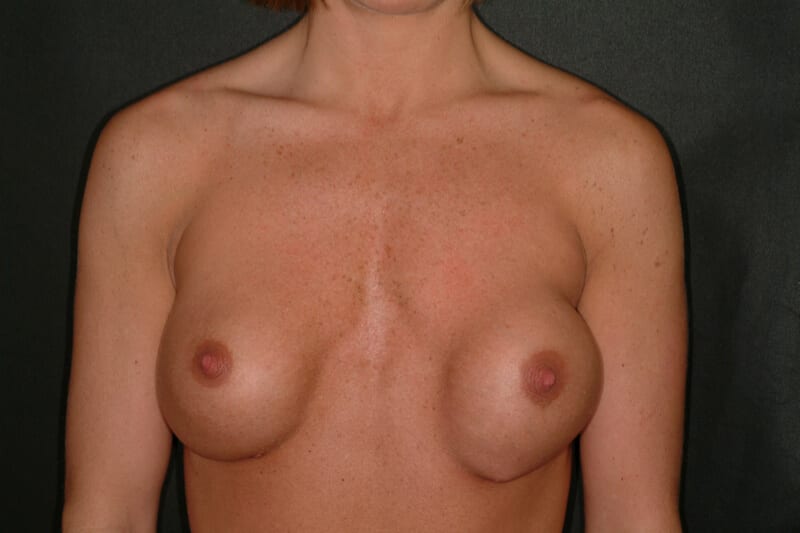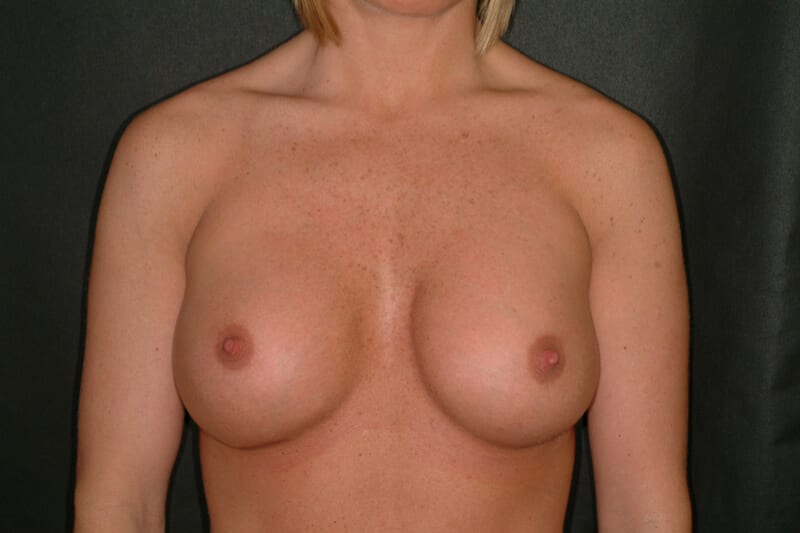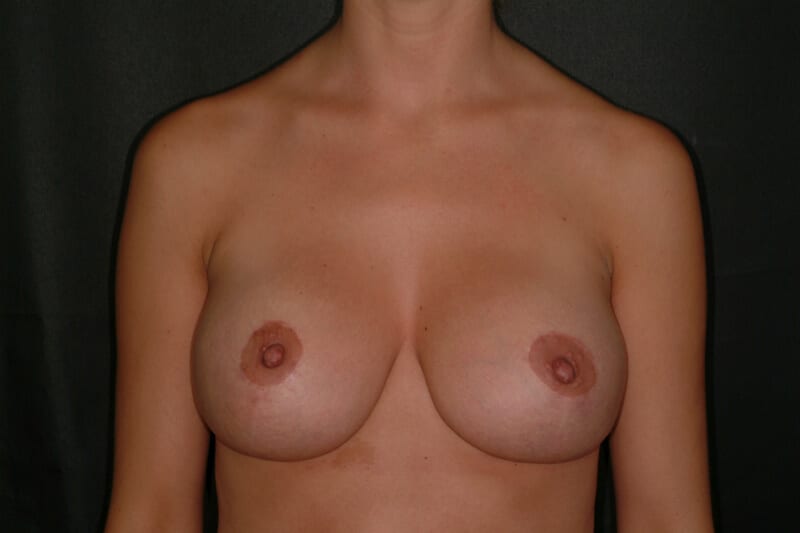Breast Revision in Buffalo, NY
Breast revision surgery is performed when a patient is experiencing complications or is dissatisfied with their results from a previous breast augmentation procedure.
This process usually requires the removal, replacement, or repositioning of an existing implant. A synthetic mesh scaffold may be needed to support weakened breast tissue. Breast revision is commonly done to change implant size, reposition the implant(s), or correct implant rupture or deflation.
Dr. Todd Koch offers breast revision surgery and implant removal for patients in the Buffalo, New York area.
What Are the Benefits of Breast Revision?
What Are the Benefits of Breast Revision?
When you first thought about having breast augmentation, you probably had the ideal results in mind. If your outcome was less than satisfactory, or complications have interfered with your appreciation of your new bust, you may want to consider a revision.
Breast revision surgery (secondary breast surgery) can:
- Improve self-esteem and confidence
- Relieve patient discomfort caused by adverse breast augmentation results
This procedure can often be performed through the previous incision site, preventing further scarring.
Sometimes there is no recourse when plans go awry, but when breast implants don’t turn out the way you expect, there is a solution.
What Are the Reasons for Breast Revision?
Breast revision is commonly done to change implant size, reposition the implant(s), or correct implant rupture or deflation.
Size
Dissatisfaction With Breast Size
- Ideal breast size varies among women and can depend on your body’s frame and personal preferences
- Poorly chosen implant sizes can create an unbalanced appearance in some women
- Your implants can be exchanged for larger implants if your desired increase in size wasn’t achieved or smaller implants if you believe your breasts are now disproportionately large or causing discomfort
- Changing the material of your implants can also affect how your implants sit and look on your chest
Rippling
Rippling or Wrinkling
- Women with thin breast tissue are more likely to develop visible ripples or wrinkles
- Saline implants are more likely to develop visible rippling or wrinkles
- Replacing saline implants with silicone implants can help restore a smoother breast appearance
Rupture
Implant Rupture or Leakage
- A natural defect in your breast implant or trauma to the implant can cause a rupture or leak
- The older your implants are, the higher the risk of rupture
- Saline ruptures are immediately noticeable and result in a deflated breast appearance
- Silicone leaks tend to occur more slowly and often require an MRI to diagnose
Capsular
Capsular Contracture
- Capsular contracture occurs when the natural scar tissue shell around the implant begins to harden and contract around the implant
- Capsular contracture can result in the breast(s) feeling hard
- In some cases, capsular contracture can cause intense discomfort
Malposition
Implant Shifting (Malposition)
- Symmastia is when implants shift laterally inward and begin to meet in the middle of your chest
- Bottoming out is when implants shift downward out of the breast pockets
- Implants can shift out of the breast pocket and into the armpits, especially while lying down
- Implant shifting generally occurs due to a weakness in the implant pocket or support tissue
Deformity
Double Bubble Deformity
- Weak breast tissue that has begun to sag accumulates under the breast implants, creating two distinct bubbles
- Double bubble can result from naturally aged breast tissue or ptosis that wasn’t treated at the time of your original augmentation
- Breast sagging can create double bubble deformity
How Is Breast Revision Performed?
-
Anesthesia
General anesthesia is usually administered prior to the procedure. However, a combination of intravenous sedation and local anesthesia is sometimes an option.
-
The Incision
The type of incision used in breast implant revision surgery will vary depending upon the incision used initially. If possible, Dr. Koch will use the same incision to avoid additional scarring. The common incision types include:
- Inframammary: along the crease under the breast
- Vertical or Wise pattern incision: from the areola to the crease — often used in breast lifts
- Periareolar incision: all or part of the way around the areolas
-
The Procedure
The unwanted or damaged implant is removed from the breast pocket. If the surrounding scar tissue is causing problems (capsular contracture), it will also be removed in part or in full (total capsulectomy or en bloc capsulectomy).
In many cases, an internal synthetic mesh (GalaFLEX®) is inserted into the breast pocket. This surgical scaffold works like an internal bra, helping to strengthen the internal tissues.
-
Closing the incisions
Sutures, skin adhesives, or tape keep the incisions closed.
Your Breast Revision Consultation
When you meet with Dr. Koch, he will listen carefully to the concerns you have about your original breast implant surgery.
Dr. Koch obtains a complete medical history to ensure that you are healthy enough for surgery.
After hearing your concerns and goals, he will discuss your options, and, together, you will determine which implant, placement, and incision type will be used.
This decision is based on the size and shape of your natural breasts, desired results, age, and other unique details.
Some of these details include how the existing breast tissue and muscles are positioned and how much pressure is normal for you to routinely put on them. For instance, placement and size for a female athlete or weightlifter might differ from that of a stay-at-home mom who intends to breastfeed.
You can even get a preview of your options with our state-of-the-art imaging technology to see how each size option will look on you.
VECTRA® XT
VECTRA® XT makes it even easier to envision your final breast revision outcome. If size or placement was an issue before, you can see how a different size, placement, or material might improve your results.
This 3D imaging system simulates your possible results by analyzing your anatomy. This technology allows you to see a preview of how your shape will change with different implant types and sizes.
VECTRA® XT is an integral part of your breast revision consultation because it offers a view into your post-surgery results. This realistic imaging allows you to opt for the implant size that will meet your individual needs.
Before & After
How Much Is Breast Revision?
The cost of your breast revision will vary depending on the cause and extent of your dissatisfaction with your initial results and current condition of your natural breasts.
A breast revision consultation with Dr. Koch, is the best way to find the answers to all your questions. You will be informed about the procedure and the cost involved, as well as your payment options.
What to Expect During Recovery
Frequently Asked Questions
-
How is breast revision surgery performed?
Your original incision site is typically used to remove your old implants. The breast pocket may be reconstructed or reinforced. Frequently, a synthetic mesh scaffold is used to support thin or weakened breast tissue (studies have shown that this material prevents recurrent capsular contracture). New implants may be inserted and positioned in the breast pocket, and your incisions are closed.
-
Am I a suitable candidate for breast revision?
Ideal candidates are in good physical health, are not pregnant or nursing, and have realistic expectations about their results. Patients suitable for surgery do not smoke, and those who do should quit several weeks before their procedure.
-
How long will my results last?
Results from breast revision are long lasting and generally show for many years or decades. Most implants are estimated to last between 10 and 20 years; however, it is possible for them to last longer, just as it is also possible for them to need replacement sooner. For ideal results, periodically visit your doctor to ensure no further complications have developed.
-
Will I experience any lasting effects from an implant rupture?
There is no medical evidence to suggest that any long-term complications, such as breast cancer are associated with implant ruptures. However, it is best to fix a rupture as soon as it is identified.
-
How long after my primary breast augmentation should I wait before undergoing breast revision?
If a medical complication develops at any point after your primary breast augmentation, see a board-certified plastic surgeon immediately to rectify it. However, if you feel you are unsatisfied with the results of your primary breast augmentation, wait until your breast swelling has completely resolved and give the implants a chance to settle into place before considering breast revision surgery. This process will vary from patient to patient, but the final results of breast augmentation are typically apparent after six months.
-
What are the possible complications after breast revision?
Just like a breast augmentation procedure, there are some risks associated with breast revision. These include:
- Bleeding
- Capsular contracture
- Implant leaks
- Rippling
- Implant shifting
- Infection
- Additional scarring



